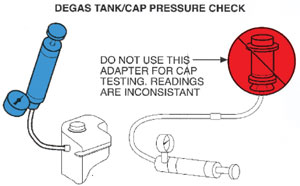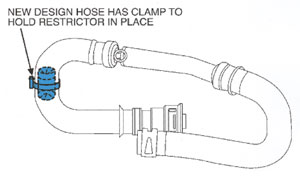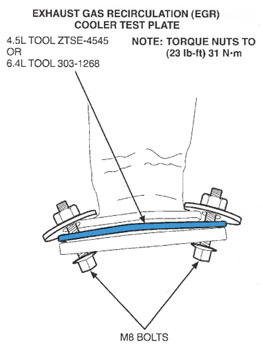By Chris Burton, ALLDATA editor, and Jeff Webster,
ALLDATA technical writer
A Ford truck, SUV or van owner may complain of a crank/no-start condition, lack of power and coolant leak. Some vehicles equipped with a 6.0L diesel engine may exhibit those symptoms, along with oil in the coolant. The coolant leak creates a low coolant condition, which may cause the engine to overheat or result in no cabin heat.

The condition typically occurs when operating the vehicle under a load such as trailer towing, uphill driving or both. Follow the Service Procedure steps in this Tech Tip to correct the condition.
Note: Only use this tech tip if oil in coolant is verified, EGR cooler will be inspected for internal leaks.
Applicable Models: 2003-’05 Excursion, 2003-’07 F-Super Duty and 2004-’08 E-350 and E-450
Parts Information
PART NUMBER PART NAME
3C3Z-9P456-AE EGR Cooler
4C3Z-9P456-AF EGR Cooler
3C3Z-6A642-AA Oil Cooler
7C2Z-18472-A Hose – Inlet Heater Core
4C2Z-8A080-AA Degas Bottle (E-Series)
4C2Z-18476-AA Heater Core (E-Series)
F6DZ-8100-A Cap – Degas Bottle

Service Procedure
Prior to making any repairs, verify the coolant level is not overfull. The new coolant fill level is at the “MIN” line of the degas bottle when cold. Overfilled coolant levels will cause coolant to vent from the degas bottle cap. If the degas bottle is not overfull, and is still venting out coolant, refer to the following.
1. Check for proper operation of the pressure cap and its seal to the degas bottle. Do not remove the pressure cap.
a. Install the pressure tester to one of the two small ports near the top of the bottle (see Figure 1).
b. Isolate the degas bottle by securely pinching off (or plugging) the other intake deaeration (small) line, and the large hose at the bottom of the bottle between the bottle and the tee fitting.
c. Pressurize the degas bottle by using slow and steady pushes on the tester pump handle (not quick jerking pushes). Pressurize the degas bottle until the gauge pressure levels off, typically between 12-18 psi (83-124 kPa).
d. Wait 30 seconds, if the gauge holds steady pressure, the pressure cap and degas bottle fill neck lip are good.
e. If the gauge pressure drops, apply soapy water around the cap to find any leaks. Check the degas bottle fill neck lip for nicks or cracks. Small nicks can be removed by light sanding with fine emery cloth. Re-pressure test, if leaks are still present, replace the pressure cap.
f. Re-pressure test again, if leaks are still present, replace the degas bottle. After verifying that the degas bottle and pressure cap are in good condition, proceed to step 2.

2. Replace the oil cooler. Ensure that the reservoir is clean of any debris and that the screen at the bottom of the reservoir is not damaged.
Note: E-Series only: On 2004 E-Series 6.0L built before 05/29/2004, also replace the heater core inlet hose; The revised hose contains an internal flow restrictor (see Figure 2). Caution: Do not perform this operation for F-Super Duty vehicles, doing so may cause poor component performance issues.
3. Prior to reassembly, remove and check the EGR cooler for leaks using the 2008 6.4L F-Super Duty or LCF EGR cooler block off adapters.
Note: A defective EGR cooler can cause coolant to vent out of the degas bottle and appear similar to head gasket failure.
a. Install block off adapters using standard screws and washers (see Figure 3).
b. Install shop air adapter and regulator and pressurize cooler to 30 psi (207 kPa). Listen for leaks.
c. If no leaks are heard, submerge the EGR cooler in clear water. Insert one end of the cooler at a time allowing entrapped air to escape.
4. If no leaks are found, do not replace the EGR cooler.
5. If leaks are found, replace the EGR cooler.
6. Flush the cooling and heater system together using Motorcraft Premium Cooling System Flush (VC-1) or equivalent.
7. Fill the cooling system using a vacuum/filler.
8. Change the engine oil and oil filter.












